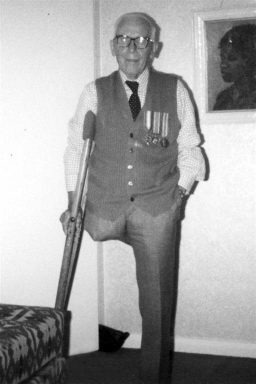
The 1921 census of England & Wales – a study of suffering. It sounds dramatic, but let’s not beat about the bush here. Close to 800,000 men did not appear in the 1921 census because they’d been killed in action, died of wounds or died of sickness and disease between 1914 and 1918. Thousands more had died in the months between December 1918 and June 1921 when the census was taken. The Great War also left over 192,000 women wiothout husbands and close to 390,000 children without fathers. Over 240,000 men had lost one or more limbs.
I was fortunate enough, in the 1980s and 1990s to meet some of the millions of men who had fought on the Western Front. Just as they could count themselves unlucky that through a quirk of fate they had been of military fighting age in the years 1914 to 1918, so I counted myslef lucky that I was able to hear their stories first-hand. I well remember, in September 1981, interviewing Alan McCartney Castle whon had lost his leg at Beaumont Hamel in November 1916 – that’s him pictured above. Mr Castle was 89 when I met him, and I had just celebrated my 19th birthday. Many of these men were as fascinated at my youth, as I was in their tales of the trenches.
Findmypast’s recent publication of the 1921 Census allows us all to see how men like Alan Castle were faring after the war. I had no idea when I interviewed him, that five years after being wounded he would still be undergoing treatment. But there he is in 1921, an in-patient at the Ministry of Pensions special surgical hospital in Ducane Road, Hammersmith.
Similarly, new institutions had sprung up to care for men who had been damaged by war. St Dunstan’s, founded in 1915 as a hostel for blinded sailors and soldiers, was thriving and had multiple branches throughout England. Its whole ethos was to train men how to be blind and it was a roaring success, later opening up branches overseas in Australia, Canada and South Africa. The charity still does stirling work today as Blind Veterans. There were other institutions too: Queen Mary’s in Sidcup for facially disfigured men, The Royal Star and Garter Home in Richmond for disabled veterans, asylums for those men who were mentally damaged, and homes for orphaned children. In other words, a legacy of suffering in a society that was still adjusting, still recuperating, still remembering.
The 1921 Census of England & Wales, offers up fascinating insights into how we in England & Wales were coping with the aftermath of that awful conflict and it’s a subject which I found fascinating and which is still revealing its secrets to me. Clicking on the link will take you straight to it, so that you can begin your own journey of discovery.
Leave a Reply
You must be logged in to post a comment.